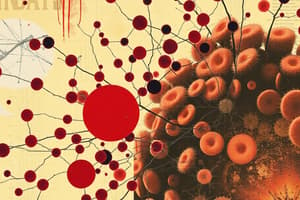Podcast
Questions and Answers
What is leukopoiesis?
What is leukopoiesis?
Production of white blood cells.
What is leukopenia?
What is leukopenia?
Decrease in white blood cell production.
What is leukocytosis?
What is leukocytosis?
Increase in white blood cell production.
Leukocytes are less numerous than red blood cells.
Leukocytes are less numerous than red blood cells.
What are the functions of leukocytes?
What are the functions of leukocytes?
Leukocytes are divided into?
Leukocytes are divided into?
PMN is?
PMN is?
Granulocytes are what?
Granulocytes are what?
What are the types of granulocytes?
What are the types of granulocytes?
Agranulocytes are called?
Agranulocytes are called?
What are the types of agranulocytes?
What are the types of agranulocytes?
What is granulopoiesis?
What is granulopoiesis?
What is the first stage of a granulocyte?
What is the first stage of a granulocyte?
Describe a myeloblast nucleus.
Describe a myeloblast nucleus.
Describe a myeloblast cytoplasm.
Describe a myeloblast cytoplasm.
What is the 2nd stage of a granulocyte?
What is the 2nd stage of a granulocyte?
What is a banded cell?
What is a banded cell?
What is neutrophilia?
What is neutrophilia?
What are some causes of neutrophilia?
What are some causes of neutrophilia?
What is neutropenia?
What is neutropenia?
What causes neutropenia?
What causes neutropenia?
A band cell is immature and comes right before a mature cell.
A band cell is immature and comes right before a mature cell.
What is left shift?
What is left shift?
What is an increase in eosinophils called?
What is an increase in eosinophils called?
What causes eosinophilia?
What causes eosinophilia?
What is a decrease in eosinophils called?
What is a decrease in eosinophils called?
What is lymphocytosis?
What is lymphocytosis?
What causes lymphocytes to increase?
What causes lymphocytes to increase?
What causes lymphopenia?
What causes lymphopenia?
What is monocytosis?
What is monocytosis?
What causes monocytosis?
What causes monocytosis?
What is a macrophage?
What is a macrophage?
What is a toxic neutrophil?
What is a toxic neutrophil?
What do toxic neutrophils: diffuse cytoplasmic basophilia indicate?
What do toxic neutrophils: diffuse cytoplasmic basophilia indicate?
What do toxic neutrophils: foamy vacuolation of cytoplasm indicate?
What do toxic neutrophils: foamy vacuolation of cytoplasm indicate?
What are Dohle bodies?
What are Dohle bodies?
What is the primary defense of a neutrophil?
What is the primary defense of a neutrophil?
Functions of platelets?
Functions of platelets?
True or False: A smudge cell is significant if numerous.
True or False: A smudge cell is significant if numerous.
What causes a stress leukogram?
What causes a stress leukogram?
Flashcards
Leukopoiesis
Leukopoiesis
The process of producing white blood cells (leukocytes) that play a crucial role in the immune system.
Leukocyte Function
Leukocyte Function
A defense mechanism against foreign invaders, involving phagocytosis, inflammation and immune responses.
Granulocytes
Granulocytes
White blood cells with granules in their cytoplasm, including neutrophils, eosinophils, and basophils.
Agranulocytes
Agranulocytes
Signup and view all the flashcards
Granulopoiesis
Granulopoiesis
Signup and view all the flashcards
Myeloblast
Myeloblast
Signup and view all the flashcards
Promyelocyte
Promyelocyte
Signup and view all the flashcards
Myelocyte
Myelocyte
Signup and view all the flashcards
Metamyelocyte
Metamyelocyte
Signup and view all the flashcards
Neutrophils
Neutrophils
Signup and view all the flashcards
Neutrophilia
Neutrophilia
Signup and view all the flashcards
Neutropenia
Neutropenia
Signup and view all the flashcards
Banded Neutrophils
Banded Neutrophils
Signup and view all the flashcards
Eosinophils
Eosinophils
Signup and view all the flashcards
Eosinophilia
Eosinophilia
Signup and view all the flashcards
Eosinopenia
Eosinopenia
Signup and view all the flashcards
Basophils
Basophils
Signup and view all the flashcards
Basophilia
Basophilia
Signup and view all the flashcards
Lymphocytes
Lymphocytes
Signup and view all the flashcards
B-lymphocytes
B-lymphocytes
Signup and view all the flashcards
T-lymphocytes
T-lymphocytes
Signup and view all the flashcards
Lymphocytosis
Lymphocytosis
Signup and view all the flashcards
Lymphopenia
Lymphopenia
Signup and view all the flashcards
Monocytes
Monocytes
Signup and view all the flashcards
Smudge Cells
Smudge Cells
Signup and view all the flashcards
Bacterial Infection (WBC Response)
Bacterial Infection (WBC Response)
Signup and view all the flashcards
Viral Infection (WBC Response)
Viral Infection (WBC Response)
Signup and view all the flashcards
Stress Leukogram
Stress Leukogram
Signup and view all the flashcards
Inflammatory Leukogram
Inflammatory Leukogram
Signup and view all the flashcards
Excitement Leukogram
Excitement Leukogram
Signup and view all the flashcards
Study Notes
Leukopoiesis Overview
- Definition: Process of producing white blood cells (leukocytes) that play a crucial role in the immune system.
- Related terms:
- Leukopenia: A decrease in white blood cell production.
- Leukocytosis: An increase in white blood cell production.
Leukocyte Characteristics
- Leukocytes are less numerous than red blood cells.
- Functions:
- Defense against foreign invaders.
- Involvement in phagocytosis (cellular ingestion of microbes).
- Participation in inflammatory responses and immune defense.
Types of Leukocytes
- Divided into two main categories:
- Granulocytes: Contain granules in their cytoplasm.
- Types include:
- Neutrophils
- Eosinophils
- Basophils
- Types include:
- Agranulocytes: Lack visible granules.
- Types include:
- Monocytes
- Macrophages (tissue-resident monocytes)
- Lymphocytes
- Plasma cells (activated lymphocytes)
- Types include:
- Granulocytes: Contain granules in their cytoplasm.
Granulocyte Development
- Granulopoiesis: Production of granulocytes.
- Stages:
- Myeloblast: Most immature form, large, rarely seen in peripheral blood.
- Promyelocyte: Second stage, lighter blue cytoplasm with non-specific granules.
- Myelocyte: Third stage, smaller, more specific granules begin to appear.
- Metamyelocyte: Fourth stage, no further cell division occurs.
Neutrophils
- Most common type of white blood cell in dogs and cats, primarily involved in fighting infections.
- Neutrophilia: Increase in neutrophils; can be caused by factors like stress, inflammation, and infections.
- Neutropenia: Decrease in neutrophils; can result from long-term steroid use or viral infections.
- Banded Neutrophils: Immature form with a horseshoe-shaped nucleus.
Eosinophils
- Characterized by pink/orange granules; involved in allergic reactions and defense against parasites.
- Eosinophilia: Increase in eosinophils commonly associated with allergies or parasitic infections.
- Eosinopenia: Decrease in eosinophils due to increased corticosteroids.
Basophils
- Contain purple granules and are involved in allergic reactions.
- Rare in circulation; thought to be tied to mast cells in tissues.
- Basophilia: Increase in basophils often in relation to allergies.
Lymphocytes
- Major producers of antibodies and main type of white blood cell in ruminants.
- Types:
- B-lymphocytes: Mature in bone marrow; develop specific receptors and can become plasma cells.
- T-lymphocytes: Mature in thymus; important for cellular immunity and activating B-cells.
- Lymphocytosis: Increase in lymphocytes due to infections or excitement.
- Lymphopenia: Decrease often caused by steroid response or Cushing's disease.
Monocytes and Macrophages
- Monocytes are larger than granulocytes, with a kidney bean-shaped nucleus.
- Functions include phagocytosis and antigen processing.
- In tissues, they differentiate into macrophages.
Smudge Cells
- Result from excessive pressure during blood film preparation or fragile cells.
- Appear as pale nuclear remnants; few are benign, many indicate cell fragility.
White Blood Cell Response to Infections
- Bacterial Infections: Typically show leukocytosis with neutrophilia followed by potential left shift.
- Viral Infections: Initial leukocytosis transitioning to leukocytopenia.
Leukogram Evaluation
- Stress Leukogram: Characterized by neutrophilia and lymphopenia.
- Inflammatory Leukogram: Shows neutrophilia with left shift.
- Excitement Leukogram: Caused by epinephrine release, showing lymphocytosis and neutrophilia without left shift.
Platelets
- Function in clotting; classified as cellular fragments from megakaryocytes, aiding hemostasis.
Studying That Suits You
Use AI to generate personalized quizzes and flashcards to suit your learning preferences.




